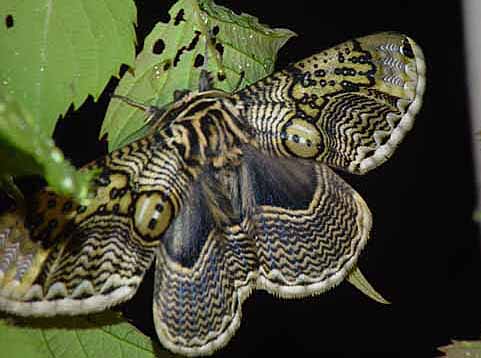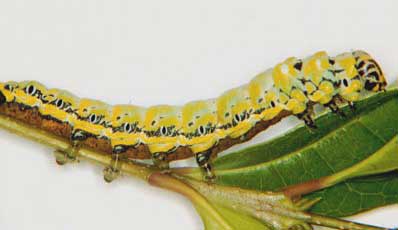Brahmaeidae
Swinhoe, 1892


The Brahmaeidae are found in the Oriental tropics, in Africa and into the warmer regions of southern Europe.
These moths often have well developed forewing eyespots (except for the Dactyloceras and possibly the Calliprogonis), earning for some species the common name of owl moth. Unlike moths of many related families, adults of this group have well developed tongues, so they can feed.
At present only four genera are recognised in this small but spectacular family:
Brahmaea Walker, 1855, the major
Oriental and Palaearctic genus;
Acanthobrahmaea Sauter, 1967,
the European genus;
Calliprogonos Mell, a
monotypic Chinese genus;
Dactyloceras Mell, 1927, an
Afrotropical genus of about eight species.
Sauter (1986) placed the last two genera in a separate subfamily, Dactyloceratinae, but this division is probably unnecessary in such a small family.
"Adults: The hindwing venation was illustrated by Holloway (1986): the cell is short, broad with the M stem present; R1 is present as a short cross-vein between Rs and Sc. In the forewing all radial veins are present except in Calliprogonos where they are reduced; R1 is weak in Dactyloceras; R3-5 arise posteriorly from Rs, and there is an interesting dichotomous arrangement of radial veins in most Brahmaea species (see below); the M stem may also be present in the cell.
"The wing pattern has features common to all species except the single Calliprogonos. On the forewing there is a medial zone flanked by two fields of multiple, parallel, fine, dark fasciae; on the hindwing only the submarginal field is present. The margins of both wings have pale semicircles across each vein but these are almost filled with black where they cross the two or three most anterior veins of the forewings.
"The male antennae are broadly bipectinate, with a weak third pectination in Brahmaea and Acanthobrahmaea (Sauter, 1986).
"In the male genitalia of Brahmaea the uncus is large, triangular, the gnathus a large, narrow loop, extensively scobinate over the distal part. The valves are approximately oval, slightly sclerotised or lobed in the distal saccular region. The aedeagus vesica is globular, usually unadorned in the South-east Asian species.
"The family is currently being studied by W. Nassig.
"Eggs: The eggs are round, flattened, like the upper third to half of a sphere, with the micropyle at the top.
"Larvae: The larvae of the Brahmaea group are usually brightly coloured or black, the segments strongly demarcated.There are long paired filaments on T2, T3 and A9, and a central one on A8. These are lost in the final instar (right), those on the thorax being replaced by 'eyespots'. More details may be found in Gardiner (1982) and Carter & Hargreaves (1986). |  |
"In Dactyloceras, segments T1 to A7 and segment A9 have paired dorsal processes, with a single long horn on A8. Those on the thorax and A8 are spinose; there is also a complete row of subspiracular processes on each side (Schultze, 1931).
"Pupae: Pupation is in the soil; there is no cocoon (Gardiner, 1982).
"Host-plant relationships: Barlow (1982) suggested that the larva of B. hearseyi was polyphagous, but records located for B. wallichii (Sevastopulo, 1940; Miyata, 1983; Gardiner, 1982) are mainly from the family Oleaceae: Fraxinus, Ligustrum, Osmanthus, but with some records from Sambucus (Sambucaceae). Carter & Hargreaves give Fraxinus and Ligustrum for Acanthobrahmaea europaea Hartig. Gardiner records Phillyrea and Syringa, also Oleaceae, for various Brahmaea.
"The only record for Dactyloceras (Schultze, 1931) is from Ceropegia in the Asclepiadaceae, a family in the same order as the Oleaceae."
Visit genera information and species lists and pictures by clicking on the hypertext below:
Brahmaea Walker, 1855, the major Oriental and Palaearctic genus;
Acanthobrahmaea Sauter, 1967, the European genus;
Calliprogonos Mell, a monotypic Chinese genus;
Dactyloceras Mell, 1927, an Afrotropical genus of about eight species.